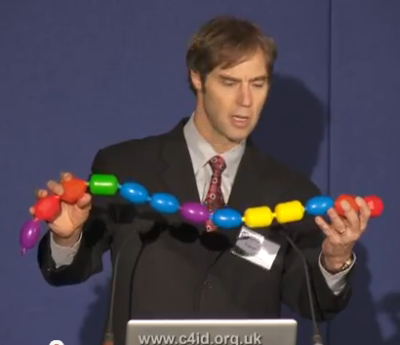I just ordered the newest edition of “The Mystery of Life’s Origin“, which is a classic book on the origin of life by pro-design authors. The new edition has several new chapters. It reminded me of my interest in the origin of life when I was a younger man, just starting full-time work with a hot Internet start-up in the big city.
Back then, I liked to listen to debates about the origin of life (e.g. – Walter Bradley versus Robert Shapiro, etc.), as well as lectures and interviews. I ordered tons of academic lectures and debates, especially from Access Research Network. Two of my favorite interviews from ARN featured Dr. Charles Thaxton and Dr. Dean Kenyon.
Let’s start with Charles Thaxton’s interview.
And here are the questions:
1. How did you first get interested in the origin of life?
2. How did you come to write The Mystery of Life’s Origin with Walter Bradley and Roger Olsen?
3. Was there an advantage to having the three of you collaborate on the project?
4. What is the primary argument of your book, The Mystery of Life’s Origin?
5. Have scientists come close to developing a plausible naturalistic explanation to the origin of life or do you still consider the origin of life to be a mystery?
6. Do you see a particular irony in the timing of Stanley Miller’s experiments and the discovery of DNA by Watson and Crick?
7. How does the emergence of modern genetics tie in with the Darwinian scenario of life going from simple to complex?
8. What are the major problems with origin of life simulation experiments?
9. Isn’t it rather impressive that amino acids were produced in the Miller experiments?
10. How close is the development of amino acids to the threshold of life?
11. What are the steps involved in producing proteins from amino acids?
12. Why are amino acids isolated during this process?
13. How can the investigator affect the outcome of a simulation experiment?
14. How did you evaluate the different chemical evolution experiments?
15. Are the initial conditions in the simulation experiments plausible?
16. What did the earth’s early atmosphere contain?
17. Will the simulation experiments work with this atmosphere?
18. There seems to be an underlying assumption that the origin of life resulted without any intelligent input whatsoever yet the simulation experiments appear to rely upon intelligent guidance. Could you comment on this irony?
19. Are there any natural processes that would have filtered out destructive ultraviolet light?
20. What additional steps beyond creating amino acids would be required to develop life?
21. What is so difficult about making proteins or nucleic acids?
22. In addition to the energy problem in protein synthesis isn’t there a sequencing problem?
23. Are DNA sequences analogous to a written language?
24. Has Hubert Yockey made similar claims?
25. In The Mystery of Life’s Origin you refer to order, randomness, and specified complexity. Could you give us an overview of these concepts?
26. What do you think the presence of specified complexity in a living system indicates about its origin?
27. In inferring the necessity of intelligence to produce life haven’t you ventured from the realm of science to religion?
28. Could you summarize the reasons why you believe intelligence was involved in the origin of life?
29. What are the major objections to your current point of view?
30. How was The Mystery of Life’s Origin received by the scientific community?
31. What was Dean Kenyon’s response to your critiques of his book, Biochemical Predestination?
32. What was Dean Kenyon’s response to The Mystery of Life’s Origin?
33. Were you a bit apprehensive about meeting Kenyon after writing a book which was quite critical of his views in Biochemical Predestination?
34. Are self-organizational theories plausible?
35. Would you comment on the work done by Prigogine and Eigen?
36. What is your assessment of RNA scenarios?
37. What other problems do you see with an RNA world?
You can learn more about Charles Thaxton here.
And here’s the interview with Dean Kenyon:
And here are the questions:
1. What first interested you in biology and the origin of life? What is your academic background in this area?
2. What was your viewpoint on the origin of life when you wrote Biochemical Predestination?
3. How have your views on the origin of life changed since you wrote Biochemical Predestination?
4. Do many of your colleagues support your new position? If not, why not?
5. What are the general presuppositions that scientists make who study the origin of life?
6. What is the Oparin-Haldane hypothesis, and what role does it play in current research and teaching on the origin of life?
7. What are the major underlying assumptions of the Oparin (chemical evolution) hypothesis?
8. Are there any other important assumptions in origin of life theories?
9. How well are these assumptions supported by currently available scientific data?
10. What is your evaluation of the Miller type of simulation experiment? What do these experiments tell us about possible chemical events on the prebiotic Earth?
11. Is it possible that interfering cross-reactions might prevent life from arising naturalistically?
12. Stanley Miller’s pioneering work in the origin of life assumed a reducing atmosphere of methane, ammonia, water vapor, and carbon dioxide? Is there sufficient empirical support for this assumption?
15. How large a gap is there between the most complex “protocell” model and the simplest living cell?
16. What is the biologically relevant information content of the simplest living organism known to exist? What are estimates for a theoretical minimum information content of the first living cell?
17. How probable is it that such complexity could arise by undirected chemical processes?
19. What are the major unsolved problems in research on the origin of life?
20. What is the relevance of the Second Law of Thermodynamics to the origin of life?
21. Is it plausible that an “RNA world” was the precursor of the first living cells?
25. If life did not originate by chemical evolution on the primitive Earth, what other possible scientific explanations exist?
26. What do you mean by your statement that “perhaps scientism is more widespread than we like to think”?
27. Is it possible that natural processes are insufficient to account for the origin of all biological information?
28. Can science rule out the possibility that most biological information had an intelligent cause?
29. What alternatives are there to pursuing purely naturalistic explanations for the origin of life?
30. What do you mean by “intelligent design” as it relates to the origin of life?
31. Why is an intelligent design or creationist interpretation of scientific data bearing on origins not acceptable to many scientists?
32. What criteria could be used to determine if the information content of living organisms had an intelligent or natural cause?
34. Does academic freedom allow you to discuss the difficulties of scientific naturalism and origin of life theories? If not, why are they protected from criticism?
35. How should the origin of life be taught in light of the California Science Framework policy which states that “nothing in science or in any other field of knowledge shall be taught dogmatically”?
36. How is scientific progress impacted when critiques of current theories are suppressed?
You can learn more about Dean Kenyon here.
The challenge for naturalists posed by the origin of life makes it well worth your time to learn and understand. I used to explain this argument to my entire IT department on white boards when I was a young man. It’s fascinating, and more convincing than personal testimonies or abstract philosophical arguments. Although I read books on the origin of life, I learned how to present the information as an argument by watching the interviews above over and over.
People sometimes ask me how I was able to survive 22 years in IT with my theism intact. It turns out that there are no shortcuts to a theistic worldview. You have to support it with evidence. You have to be able to show your work about how you reached your conclusions. I’m a theist today because I never found a single atheist in any software development job who could even begin to challenge the evidence that I collected from listening to all those lectures and debates that I started from in my early 20s. It was as easy to defeat them as taking candy from a baby.
If only Christian parents and Christian leaders understood the importance of scientific facts when they talk to young people about Christianity. We need to be less worried about hurting the feelings of young people by making them “feel dumb”. Christianity isn’t supposed to be easy. It’s not a bad thing to ask people to work hard at learning how to rationally ground it with evidence. If we want to stop our young people from being lazy, ignorant and cowardly, then the right way to do it is to make them work. Make them learn. Make them fight.



